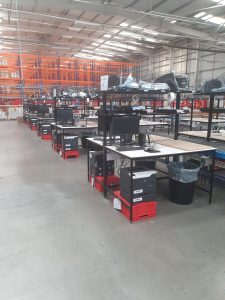Your basket is currently empty!

To remain successful, warehouse operators must continually strive to ensure they’re running at optimal performance.
Warehouse automation is an asset to such an ambition. An advantageous solution, it’s an umbrella term that refers to a wide range software, equipment and technology used onsite that automates key tasks, including inventory and storage, picking orders and packing and shipping them and keeping track of all goods in and out in real time.
The aims of warehouse automation are manifold and include streamlining processes, reducing manual labour, improving health and safety, enhancing operational efficiency and decreasing errors occurring in the supply chain. In this blog, we’ll take a deep dive into warehouse automation and the benefits it brings to companies trying to stay ahead of their competition.
Types of warehouse automation
Physical and digital automation are two types of warehouse automation. Physical automation includes using robots, automated picking systems and conveyor belts, among other equipment to manage and move inventory while digital automation refers to data analytics and software that manages inventory, optimises workflow, tracks orders, and handles data entry and order processing.
Common examples of warehouse automation are Automated Storage and Retrieval Systems or “AS/RS” for short and Goods-to-Person (GTP) Systems. AS/RS systems are designed to automatically store and collect items. They often use cranes or robots to take goods in and out of storage. GTP systems, on the other hand, bring goods to workers so orders can be picked and packed so they don’t need to waste time retrieving goods.
Robots and automated vehicles are also examples of physical warehouse automation. They may move products on pre-programmed routes while navigating using sensors, or identify and pick orders from storage areas quickly.
Drones see increasing use in warehouse environments to automate and enhance various tasks, especially inventory management. Drones navigate autonomously, scanning barcodes and transmitting useful data to warehouse management systems (WMS), reducing errors and manual labour. Drones are also used for other tasks like warehouse inspections and spare parts delivery.
WMS are digital solutions. Dedicated software systems, they help track orders, manage inventory and coordinate warehouse activities to streamline day-to-day operations. They also provide warehouse managers with valuable insights, an overview of their entire operations and remote access for ease of use.
Automated warehouse benefits
There are a multitude of benefits that warehouse operations access when they employ automation. However, these advantages don’t only serve business owners, but their staff and customers as well.
Warehouse managers find it easier to manage processes with automation, making their job simpler. For instance, at any given moment they can capture a clear picture of stock levels thanks to the improved inventory accuracy offered by automation. In turn this avoids overstocks, and supports stock turnover avoiding waste, damage and loss of space. Automation also helps warehouse operators adopt better space utilisation policies allowing them to make the most of their capacity.
Automation frees up employees to tackle more important or complex tasks and helps manages the manual labour aspect of their role. Not only does this mean increased productivity for warehouses, but also enhanced health and safety onsite with heavy lifting handled effectively without harm or hazards for workers.
Faster order fulfilment is also possible with automation. This allows companies to complete work quicker and take on new orders, boosting profitability, but also means that customers enjoy an excellent service and receive goods in a timely fashion.
Cost savings of warehouse automation
Automated warehouses are often more cost-effective to run than traditional sites. Understandably, automation leads to significant savings as it improves efficiency levels, decreases errors and optimises the use of resources. Through automating tasks, companies can also reduce labour costs, minimise human errors, maximise inventory management, and optimise space utilisation, which ultimately results in a warehouse operation that is more profitable.
Business success through warehouse automation
To sum up, warehouse automation is the process of using the latest technological advances to optimise onsite operations where goods are stored, picked, packed and shipped. Automation involves both physical and digital solutions and helps business save money.
Automation of tasks reduces running costs and improves health and safety for employees while making their physical workload easier. It reduces errors and offers increased efficiency levels for companies and ensures they always operate at the top of their game.
You may also interested in:

How repairing damaged warehouse equipment beats replacing entirely
A White Paper by Southgate Global has detailed how repairing warehouse equipment instead of
Warehouse operators warned about energy compliance crisis
New energy regulations could render some warehouse space unusable by 2030 due to
